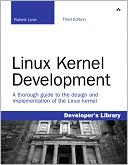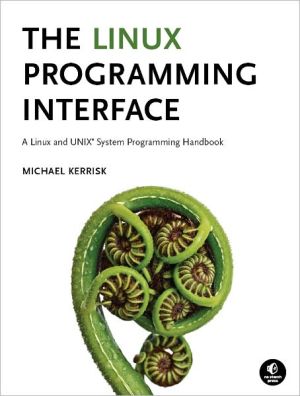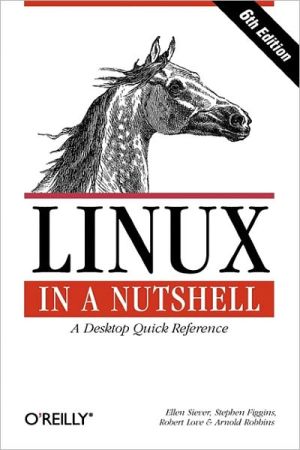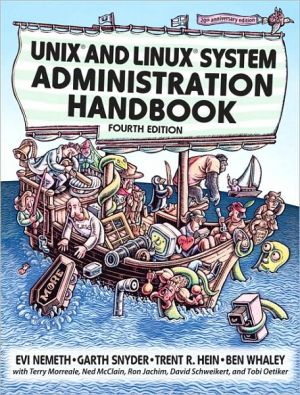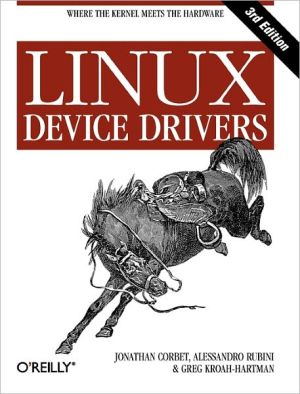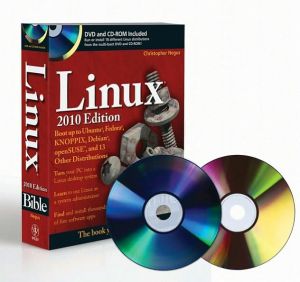Linux Administration Handbook
“As this book shows, Linux systems are just as functional, secure, and reliable as their proprietary counterparts. Thanks to the ongoing efforts of thousands of Linux developers, Linux is more ready than ever for deployment at the frontlines of the real world. The authors of this book know that terrain well, and I am happy to leave you in their most capable hands.”\ —Linus Torvalds\ “The most successful sysadmin book of all time—because it works!”\ —Rik Farrow, editor of ;login:\ “This book...
Search in google:
“As this book shows, Linux systems are just as functional, secure, and reliable as their proprietary counterparts. Thanks to the ongoing efforts of thousands of Linux developers, Linux is more ready than ever for deployment at the frontlines of the real world. The authors of this book know that terrain well, and I am happy to leave you in their most capable hands.”—Linus Torvalds“The most successful sysadmin book of all time—because it works!”—Rik Farrow, editor of ;login:“This book clearly explains current technology with the perspective of decades of experience in large-scale system administration. Unique and highly recommended.”—Jonathan Corbet, cofounder, LWN.net“Nemeth et al. is the overall winner for Linux administration: it’s intelligent, full of insights, and looks at the implementation of concepts.” —Peter Salus, editorial director, Matrix.netSince 2001, Linux Administration Handbook has been the definitive resource for every Linux® system administrator who must efficiently solve technical problems and maximize the reliability and performance of a production environment. Now, the authors have systematically updated this classic guide to address today’s most important Linux distributions and most powerful new administrative tools.The authors spell out detailed best practices for every facet of system administration, including storage management, network design and administration, web hosting, software configuration management, performanceanalysis, Windows interoperability, and much more. Sysadmins will especially appreciate the thorough and up-to-date discussions of such difficult topics such as DNS, LDAP, security, and the management of IT service organizations.Linux® Administration Handbook, Second Edition, reflects the current versions of these leading distributions:Red Hat® Enterprise Linux®FedoraTM CoreSUSE® Linux EnterpriseDebian® GNU/LinuxUbuntu® LinuxSharing their war stories and hard-won insights, the authors capture the behavior of Linux systems in the real world, not just in ideal environments. They explain complex tasks in detail and illustrate these tasks with examples drawn from their extensive hands-on experience. Booknews Provides techniques and advice for running three representative versions of the Linux operating system: Red Hat 7.2, SuSE 7.3, and Debian 3.0. The guide identifies the different pieces that comprise the major administrative systems and how they work together, and summarizes how to perform common procedures, such as adding and removing users, performing backups, and auditing security. Large sections are devoted to the domain name system configuration and the sendmail configuration. Annotation c. Book News, Inc., Portland, OR (booknews.com)
When we wrote the first edition of this book (about five years ago), Linux was just beginning to prove itself in the corporate world. We hoped that Linux Administration Handbook would help spread the news that Linux was a first-tier operating system capable of matching off against offerings from Sun, HP, and IBM.\ Now Linux is IBM. For anyone awaiting an unambiguous signal that the Linux waters were safe for corporate swimmers, IBM’s 2004 announcement of Linux support across its entire server line must have been quite comforting. No one was ever fired for buying IBM; these days, Linux in general is an equally safe proposition.1\ We set out to write a book that would be the professional Linux system administrator’s best friend. Where appropriate, we’ve adapted the proven concepts and materials from our popular book, UNIX System Administration Handbook. We’ve added a truckload of Linux-specific material and updated the rest, but much of the coverage remains similar. We hope you agree that the result is a high-quality guide to Linux administration that benefits from its experience in a past life.\ None of the other books on Linux system administration supply the breadth and depth of material necessary to effectively use Linux in real-world business environments. Here are the features that distinguish our book:\ \ We take a practical approach. Our purpose is not to restate the contents of your manuals but rather to summarize our collective experience in system administration. This book contains numerous war stories and a wealth of pragmatic advice.\ This is not a book about how to run Linux at home, in your garage, oron your PDA. We describe the use of Linux in production environments such as businesses, government offices, and universities.\ We cover Linux networking in detail. It is the most difficult aspect of system administration and the area in which we think we can be of most help.\ We do not oversimplify the material. Our examples reflect true-life situations with all their warts and unsightly complications. In most cases, the examples have been taken directly from production systems.\ We cover five major Linux distributions.\ \ Our Example DistributionsLike so many operating systems, Linux has grown and branched in several different directions. Although development of the kernel has remained surprisingly centralized, packaging and distribution of complete Linux operating systems is overseen by a variety of groups, each with its own agenda.We cover five Linux distributions in detail:\ \ Red Hat® Enterprise Linux® 4.3 ES\ FedoraTM Core 5\ SUSE® Linux Enterprise 10.2\ Debian® GNU/Linux 3.2 “Etch” (testing release of 9/06)\ Ubuntu® 6.06 “Dapper Drake”\ \ We chose these distributions because they are among the most popular and because they represent the Linux community as a whole. However, much of the material in this book applies to other mainstream distributions as well.\ We provide detailed information about each of these example distributions for every topic that we discuss. Comments specific to a particular operating system are marked with the distribution’s logo.The Organization of This Book\ This book is divided into three large chunks: Basic Administration, Networking, and Bunch o’ Stuff.\ Basic Administration presents a broad overview of Linux from a system administrator’s perspective. The chapters in this section cover most of the facts and techniques needed to run a stand-alone Linux system.\ The Networking section describes the protocols used on Linux systems and the techniques used to set up, extend, and maintain networks. High-level network software is also covered here. Among the featured topics are the Domain Name System, the Network File System, routing, sendmail, and network management.\ Bunch o’ Stuff includes a variety of supplemental information. Some chapters discuss optional software packages such as the Linux printing system. Others give advice on topics ranging from hardware maintenance to the politics of running a Linux installation.\ Each chapter is followed by a set of practice exercises. Items are marked with our estimate of the effort required to complete them, where “effort” is an indicator of both the difficulty of the task and the time required.There are four levels:\ \ no stars—Easy, should be straightforward\ one star—Harder or longer, may require lab work\ two stars—Hardest or longest, requires lab work and digging\ three stars—Semester-long projects (only in a few chapters)\ \ Some of the exercises require root or sudo access to the system; others require the permission of the local sysadmin group. Both requirements are mentioned in the text of the exercise.Our Contributors\ We’re delighted that Adam Boggs, Bryan Buus, and Ned McClain were able to join us once again as contributing authors. With this edition, we also welcome Ben Whaley, Tobi Oetiker, Fritz Zaucker, Jeffrey S. Haemer, David Schweikert, and Scott Seidel as contributors and friends. Their deep knowledge of a variety of areas has greatly enriched the content of this book. Above all, we thank and acknowledge Lynda McGinley, who in addition to taking ownership of a substantial amount of text also worked tirelessly to organize and facilitate our contributors’ work.Contact Information\ Please send suggestions, comments, and bug reports to linux@book.admin.com. We answer most mail, but please be patient; it is sometimes a few days before one of us is able to respond. Because of the volume of email that this alias receives, we regret that we are unable to answer technical questions. To get a copy of our current bug list and other late-breaking information, visit our web site, www.admin.com.\ We hope you enjoy this book, and we wish you the best of luck with your adventures in system administration!\ Evi Nemeth\ Garth Snyder\ Trent R. Hein\ \ October 2006\ Note\ 1. At least on servers. Today’s battleground is the desktop, a domain over which Microsoft Windows still maintains a near-lock. The outcome of that struggle remains difficult to predict. As of this writing, Windows still provides a more polished user interface. But it’s hard to argue with “free.”
1. Where to Start2. Booting and Shutting Down3. Rootly Powers4. Controlling Processes5. The Filesystem6. Adding New Users7. Serial Devices8. Adding A Disk9. Periodic Processes10. Backups11. Syslog and Log Files12. Drivers and the Kernel13. TCP/IP Networking14. Routing15. Network Hardware16. The Domain Name System17. The Network File System18. Sharing System Files19. Electronic Mail20. Network Management and Debugging21. Security22. Web Hosting and Internet Servers23. Printing24. Maintenance and Environment25. Performance Analysis26. Cooperating with Windows27. Policy and Politics28. Daemons
\ From Barnes & NobleThe Barnes & Noble Review\ There are plenty of Linux administration books. Several things make this one stand out. Here's the most important: Linux Administration Handbook is designed for administrators working in industrial-strength production environments. \ It never glosses over the "subtleties" that can get you in big trouble. It doesn't stint on technical detail. It's never satisfied with restating the man pages. And it's full of war stories from folks who've been there. Evi Nemeth and her coauthors: Boy, have they ever been there. (Just ask any gray-bearded Unix sysadmin about their earlier, legendary Unix System Administration Handbook.)\ There's only been one downside to Linux Administration Handbook: It's been nearly five years since it was written. Well, that flaw's just been remedied. The new Second Edition has been systematically revised for the latest administration tools (think Nagios and LVM). It's carefully targeted at today's five most widely used distributions: Red Hat Enterprise Linux 4.3, Fedora Core 5, SUSE Linux 10.2, Debian 3.2 "Etch," and Ubuntu 6.06. The result: a book you can rely on for the next five years.\ Rely on to do what? Just about everything. You'll find chapters on booting and shutting down; "rootly" powers; controlling processes; the Linux filesystem; on adding new users. You'll learn the most efficient ways to perform backups. How to make sense of syslogs and log files. Everything you need to know about drivers, the kernel, networking, NFS -- and Internet services, from web hosting to email. Nemeth & Company bring their experience to bear on troubleshooting, performance optimization, print management, security, Windows interoperability, even "policies and politics."\ Whatever Linux books you already own, if you depend on Linux to run efficiently and reliably, you need this one, too. Bill Camarda, from the December 2006 Read Only\ \ \ \ \ \ Provides techniques and advice for running three representative versions of the Linux operating system: Red Hat 7.2, SuSE 7.3, and Debian 3.0. The guide identifies the different pieces that comprise the major administrative systems and how they work together, and summarizes how to perform common procedures, such as adding and removing users, performing backups, and auditing security. Large sections are devoted to the domain name system configuration and the sendmail configuration. Annotation c. Book News, Inc., Portland, OR (booknews.com)\ \

